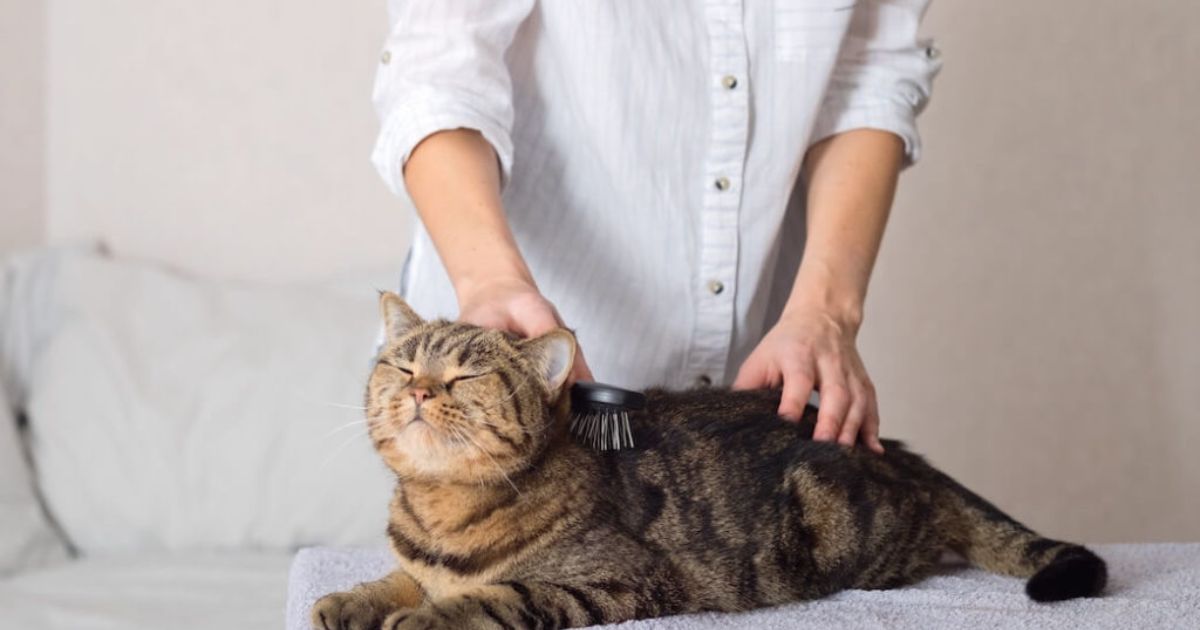Has your feline friend been leaving flakes of dandruff all over your furniture lately? Dandruff in cats, also known as scurf, can indicate a few different issues. While a sprinkle of cat dandruff here and there is normal, especially in dry environments, excessive flaking and itchiness signifies a problem.
In this in-depth guide, we’ll cover the causes, symptoms, diagnostics, and solutions for cat dandruff so you can get your kitty’s coat looking healthy again. With a few adjustments to care and treatment when necessary, your cat’s bothersome flaky skin will be under control in no time.
What is Dandruff?
Dandruff refers to dry, flaky skin that sheds from your cat’s body. Also called seborrhea or scurf, dandruff consists of dead skin cells that build up in excess and shed in clumps from your cat’s coat.
A small amount of dandruff is common as cats groom and renew the top layer of their skin cells. But excessive dandruff or flaking indicates an underlying issue like:
- Dry, irritated skin
- Allergies
- Parasites
- Skin infections
- Hormonal imbalances
- Nutritional deficiencies
- Systemic illnesses
Dandruff can occur anywhere on your cat’s body but most often develops along the back, stomach, legs, base of the tail, and head. It’s important to determine the underlying cause of your cat’s flaky skin rather than just treating the symptoms for the best resolution.
What Causes Dandruff in Cats?
Dandruff results from an abnormal turnover and shedding of skin cells. Normally, feline skin cells take 30-40 days to move from the bottom layers of the epidermis up to the surface, where they flake off during self-grooming. Dandruff forms when dead skin cells from deeper layers reach the surface too quickly before they’re fully mature. This can happen for many reasons:
Environmental Causes
Dry, cold winter air in our homes can sap moisture from your cat’s skin. Indoor cats are especially prone to dry air dandruff in winter when the furnace is running frequently. Dry skin gets flaky, irritated and itchy.
High humidity in summer can also irritate your cat’s skin and cause flaking. Make sure your home’s humidity levels stay between 30-50%. Use a humidifier if needed to prevent dandruff and skin problems.
Dietary Causes
- Poor nutrition can lead to dry, itchy skin. Many inexpensive cat foods lack sufficient nutrients for skin and coat health. Diets deficient in fatty acids, vitamins and minerals fail to properly moisture and condition your cat’s coat. This allows dead skin cells to accumulate and flake off.
- Allergies to foods or food additives are a very common cause of dandruff and skin irritation as cats have immune reactions. Cats may develop flakes, scabs and extremely itchy skin when allergic to ingredients like corn, wheat, dairy products or chicken.
Health Conditions Causing Cat Dandruff
Various health conditions that disrupt the normal skin renewal process can trigger excessive dandruff, including:
- Skin infections like ringworm or mange cause flaky skin along with hair loss and skin lesions. Microscopic mites burrow into the skin and stimulate inflammation and rapid cell turnover.
- Endocrine disorders like hyperthyroidism or Cushing’s disease throw off the delicate balance of hormones needed for skin health.
- Kidney disease and dehydration leave skin dry, itchy and flaky. Illnesses like diabetes and hyperthyroidism impair kidney function.
- Heart disease or low blood pressure may impede circulation, depriving the skin of nutrients and moisture it needs.
- Cancers like lymphoma disrupt healthy cell growth and can first manifest with skin problems like severe flaking.
- Immune mediated skin diseases like pemphigus foliaceus cause the immune system to attack healthy skin cells. This leads to crusting sores and severe dandruff.
- Even reactions to medications or toxins can spark flaky skin.
As you can see, dandruff can stem from many sources – some mild, others very serious and even life threatening if left untreated. That’s why it’s so important to find and address the root cause, not just slather on anti-dandruff shampoo.
Symptoms of Cat Dandruff
Be on the lookout for these signs of excessive dandruff in your cat:
Obvious Flaking
- Flaky or greasy accumulations in your cat’s coat
- Visible crusts and white scales forming on the skin
Skin Irritation
- Increased scratching, licking, biting, or rubbing as your cat itches
- Scabs, sores or irritation from trauma
- Red, inflamed areas
Coat Changes
- Dull, brittle fur
- Discoloration
- Excess shedding
- Matted clumps
Behavior Changes
- Discomfort
- Changes in sleeping spots, anxiety
- Decreased grooming
Odor
- Musty, yeasty smell, especially if skin infected
Underlying health issues may also cause additional symptoms like:
- Excessive panting, tiredness or muscle tremors can indicate hyperthyroidism
- Vomiting, diarrhea, lack of appetite, weight loss can signal gastrointestinal disease
- Itchiness, inflamed skin, lesions may arise with skin infections
- Disorientation, seizures can result from organ failure or cancers
- Fever, enlarged lymph nodes may signal infections or immune disease
Don’t dismiss excessive dandruff as just dry skin or allergies. Serious diseases like kidney failure need prompt veterinary diagnosis and care. Watch for any other signals that something may be wrong.
Solutions for Cat Dandruff
To banish dandruff flakes from your cat, you need to both treat the symptoms for immediate relief and address underlying causes:
Improve Grooming
Brush your cat frequently to gently remove dead flakes before they fall and distribute natural skin oils. Use a stainless steel comb to detangle and exfoliate.
Bathe your cat every 1-2 weeks with a mild, veterinarian recommended anti-dandruff or anti-seborrhea shampoo. Follow directions carefully. Rinse thoroughly.
Feed a High Quality Diet
Choose a premium cat food with excellent digestibility and nutrients for skin health like omega fatty acids and vitamin E.
For suspect food allergies, try an elimination diet under your vet’s guidance to identify problem ingredients. Then feed a limited ingredient diet without those triggers.
Hydration is key – make sure your cat eats plenty of wet food or add water to dry food to increase moisture intake. Dehydration worsens dandruff.
Control Environmental Triggers
Use a humidifier to maintain 40-50% humidity and prevent dry air dandruff. Clean humidifiers frequently to avoid mold risks.
Avoid extremes in temperature that stress skin – keep home between 65-78°F. Don’t overbundle or overheat your cat.
Address Any Underlying Conditions
- Manage diseases like hyperthyroidism to minimize skin disruption
- Treat skin infections as soon as possible
- Follow your vet’s recommendations to resolve food allergies
- Give medications, supplements as prescribed
Diagnosing the Cause of Cat Dandruff
Schedule a veterinary exam if your cat has severe, worsening dandruff or any signs of illness. Diagnosing the root cause is crucial for proper treatment.
Your vet will begin by:
- Asking about your cat’s symptoms – when the dandruff started, if your cat is itching or acting ill, any changes in environment or diet, etc.
- Examining your cat’s skin – observing flaking amount and location, inflammation, lesions, etc.
- Evaluating your cat’s overall health – checking vitals, weight changes, lymph nodes, etc.
Diagnostic tests may include:
- Skin scrapings – using a scalpel blade to collect skin samples and examine under a microscope for evidence of ringworm fungi or sarcoptic mange mites. Skin cytology may also be performed.
- Fungal culture – growing a skin sample in the lab to identify any fungal organisms.
- Blood work – complete blood count, blood chemistry panel and thyroid tests to evaluate overall health and look for indicators of infections, kidney disease, diabetes, hyperthyroidism and other conditions.
- Urinalysis – checks kidney function and diabetes.
- Biopsies – skin punch biopsies may be collected and sent to a pathologist if infection is uncertain. Biopsies help diagnose immune diseases, cancers and allergies.
- Diet trials – your vet may recommend putting your cat on an elimination diet or hypoallergenic diet for 2-3 months to see if restricting certain ingredients improves skin flaking and itch.
With diagnostic testing, your veterinarian will determine the cause of your cat’s dandruff and recommend the appropriate treatment plan.
Treating Cat Dandruff
Treatment will depend on the underlying cause but may include:
For infections:
- Oral or topical antifungal medications for ringworm
- Antibiotics for bacterial infections
- Antiparasitics to kill mites causing mange
For allergies:
- Anti-itch medication for temporary relief
- Allergen-specific immunotherapy (“allergy shots”)
- Diet change – novel protein or hydrolyzed protein foods
For hormonal disorders:
- Medications to manage hyperthyroidism, Cushing’s disease
For kidney disease:
- Fluids, diet change, phosphorus binders
- Treatments to balance electrolytes, minerals
- Medications to control blood pressure, anemia
For circulatory disorders:
- Medications like ACE inhibitors to improve heart function
- Emergency care for clots, arrhythmias, heart failure
For immune disease:
- Corticosteroids to reduce inflammation
- Other immunosuppressants as needed
For cancers:
- Surgery to remove localized tumors
- Chemotherapy or radiation treatments
General approaches:
- Omega fatty acid supplements
- Vitamins and minerals for nutritional deficiencies
- Hypoallergenic diets
- Anti-seborrhea shampoos with antifungal, antibacterial ingredients
- Antiseptic cleansers recommended short-term for infections
- Topical therapy – creams, oils to moisturize and protect skin
- Elizabethan collars to prevent scratching
- Physical therapy for mobility issues, arthritis
Relieving your cat’s dandruff requires patience and perseverance. It takes diligence to successfully treat infections, manage chronic diseases, and resolve allergic skin conditions. Follow your veterinarian’s treatment plan fully and schedule all prescribed rechecks. Monitor your cat’s symptoms in the meantime and alert the vet to any worsening conditions.
With the right diagnosis and care, most cats fully recover from dandruff issues and discomfort. Their skin irritation resolves, coats grow back soft, smooth and flake free so you can cuddle without “dandruff storms” again!
When to See the Veterinarian
Schedule an exam promptly if your cat has:
- Severe, worsening flaking and itching
- Scabs, sores, swelling or hair loss
- Signs of skin infection like discharge, odor or crusts
- Any symptoms of lethargy, appetite changes or possible illness
Cats often hide illnesses until advanced stages when treatment is more involved. Don’t wait on potential conditions like infections or kidney failure – seek prompt veterinary help as soon as you notice anything unusual.
Related Post:
FAQs About Cat Dandruff:
Is dandruff dangerous to my cat?
Dandruff itself is more a nuisance than dangerous. But untreated allergies, infections and other underlying problems that cause dandruff can progress over time and threaten your cat’s health. It’s important to identify and address the root cause.
Can I just use human anti-dandruff shampoo?
No, human shampoos are the wrong pH for cat skin and may contain ingredients unsafe if licked. Use a veterinarian recommended cat shampoo. Never use human dandruff medication like selenium sulfide or coal tar on cats.
Should I give my cat fish oil for dandruff?
You can try omega-3 fatty acid supplements, but the dosage must be carefully calculated based on your cat’s size. Too much fish oil can lead to vitamin E deficiency. Check with your vet on using fish oil.
Can dandruff go away on its own?
Mild dandruff may resolve with added humidity, more brushing and a better diet. But significant dandruff, skin irritation, hair loss or other symptoms must be checked by your vet to diagnose the underlying problem and prescribe appropriate treatment.
How long does it take for cat dandruff treatments to work?
It depends on the cause. Parasites and infections should improve within 2-4 weeks with medications. Allergy relief through diet can take 2-3 months. Dandruff related to chronic diseases may recur. Follow your vet’s treatment plan and schedule rechecks as advised.









